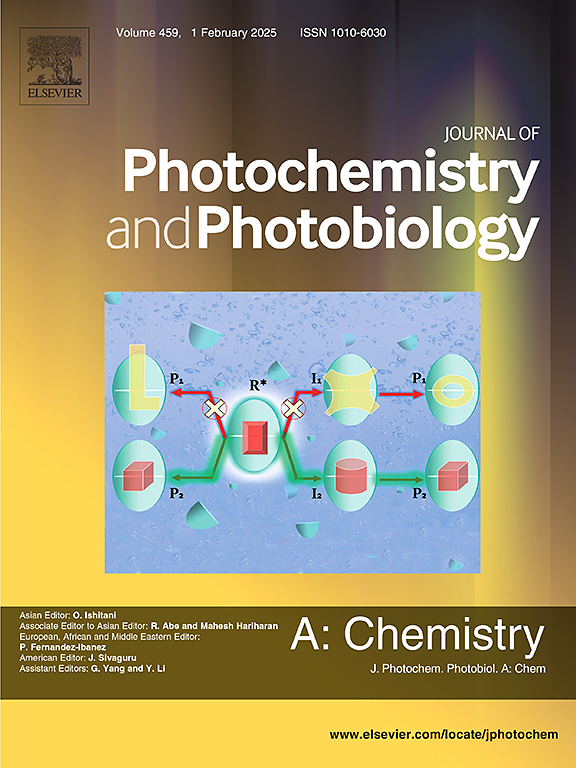Au-modified In2O3 nanoparticles for photocatalytic degradation of diverse antibiotics
IF 4.1
3区 化学
Q2 CHEMISTRY, PHYSICAL
Journal of Photochemistry and Photobiology A-chemistry
Pub Date : 2025-03-13
DOI:10.1016/j.jphotochem.2025.116366
引用次数: 0
Abstract
The co-existence of diverse antibiotics in wastewater systems necessitates the development of multifunctional catalysts for simultaneous pollutant remediation. While indium oxide (In2O3) presents advantages as a semiconductor photocatalyst through its high electrical conductivity, low resistivity, and inherent oxygen vacancies, practical applications in broad-spectrum pollutant degradation remain constrained by rapid charge carrier recombination and limited visible-light utilization efficiency. To address these challenges, we developed plasmonic Au nanoparticle-decorated In2O3 composites (AuNPs/In2O3) via a controlled in-situ reduction strategy. Systematic characterization revealed that the localized surface plasmon resonance (LSPR) effect of Au nanoparticles synergistically enhanced UV–vis absorption characteristics while effectively suppressing photogenerated electron-hole recombination, as evidenced by photoelectrochemical analyses including transient photocurrent response and electrochemical impedance spectroscopy. The optimized AuNPs/In2O3 hybrid demonstrated exceptional photocatalytic performance, achieving 99.0 % degradation efficiency for both ofloxacin and tetracycline antibiotics under visible-light irradiation, along with remarkable cycling stability (>90 % efficiency retention after three cycles) and practical applicability across varied water matrices. Mechanistic investigations through radical trapping experiments identified the predominant roles of hole (h+) and superoxide radical (·O2−) species in the multi-pathway degradation processes. This study not only provides an effective strategy for engineering plasmon-enhanced In2O3 photocatalysts but also establishes a methodological framework for developing multifunctional catalytic systems for environmental remediation.

求助全文
约1分钟内获得全文
求助全文
来源期刊
CiteScore
7.90
自引率
7.00%
发文量
580
审稿时长
48 days
期刊介绍:
JPPA publishes the results of fundamental studies on all aspects of chemical phenomena induced by interactions between light and molecules/matter of all kinds.
All systems capable of being described at the molecular or integrated multimolecular level are appropriate for the journal. This includes all molecular chemical species as well as biomolecular, supramolecular, polymer and other macromolecular systems, as well as solid state photochemistry. In addition, the journal publishes studies of semiconductor and other photoactive organic and inorganic materials, photocatalysis (organic, inorganic, supramolecular and superconductor).
The scope includes condensed and gas phase photochemistry, as well as synchrotron radiation chemistry. A broad range of processes and techniques in photochemistry are covered such as light induced energy, electron and proton transfer; nonlinear photochemical behavior; mechanistic investigation of photochemical reactions and identification of the products of photochemical reactions; quantum yield determinations and measurements of rate constants for primary and secondary photochemical processes; steady-state and time-resolved emission, ultrafast spectroscopic methods, single molecule spectroscopy, time resolved X-ray diffraction, luminescence microscopy, and scattering spectroscopy applied to photochemistry. Papers in emerging and applied areas such as luminescent sensors, electroluminescence, solar energy conversion, atmospheric photochemistry, environmental remediation, and related photocatalytic chemistry are also welcome.

 求助内容:
求助内容: 应助结果提醒方式:
应助结果提醒方式:


